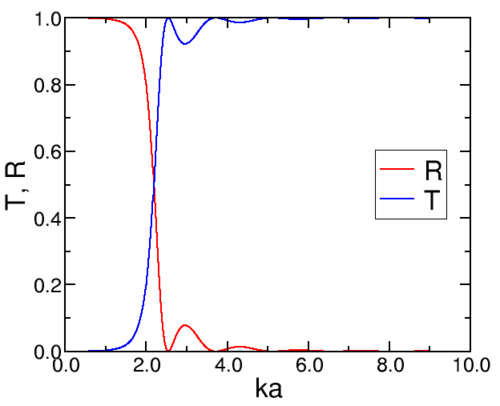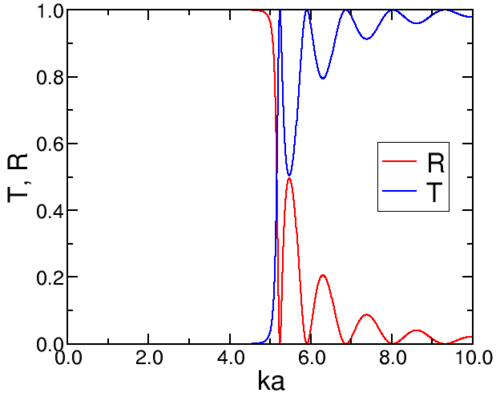6.3: Square Barrier
- Page ID
- 14783
A slightly more involved example is the square potential barrier, an inverted square well, see Figure \(\PageIndex{1}\).

Figure \(\PageIndex{1}\): The square barrier.
We are interested in the case that the energy is below the barrier height, \(0< E< V_0\). If we once again assume an incoming beam of particles from the right, it is clear that the solutions in the three regions are
\[ \begin{align} ϕ_I ( x ) &= A_1 e^{i k x} + B_1 e ^{− i k x} \\[5pt] ϕ_{II} ( x ) &= A_2 \cosh ( κ x ) + B_2 \sinh ( κ x ) \\[5pt] ϕ_{III} ( x ) &= A_3 e^{ i k x}. \label{6.16} \end{align}\]
Here
\[k = \sqrt{\dfrac{2 m}{ℏ^2} E} \]
and
\[κ = \sqrt{\dfrac{2 m}{ℏ^2} ( V_0 − E )} . \label{6.17}\]
Matching \(ϕ_I\) and \(ϕ_{II} \) at \(x=− a\) and \(ϕ_{II}\) and \(ϕ_{III} \) at \(x= a\) gives (use \(\sinh (− x)=− \sinh x\) and \(\cosh (− x)= \cosh x\)).
\[ \begin{align} A_1 e^{−ika} + B_1 e^{ika} &= A_2 \cosh κ a − B_2 \sinh κ a \label{6.18} \\[5pt] i k ( A_1 e^{−ika} − B_1 e^{ika} ) &= κ ( − A_2 \sinh κ a + B_2 \cosh κ a ) \label{6.19} \\[5pt] A_3 e^{ika} &= A_2 \cosh κ a + B_2 \sinh κ a \label{6.20} \\[5pt] i k ( A_3 e^{ika} ) &= κ ( A_2 \sinh κ a + B_2 \cosh κ a ) \label{6.21} \end{align}\]
These are four equations with five unknowns. We can thus express for of the unknown quantities in one other. Let us choose that one to be \(A_1\), since that describes the intensity of the incoming beam. We are not interested in \(A_2\) and \(B_2\), which describe the wave function in the middle. We can combine the equation above so that they either have \(A_2\) or \(B_2\) on the right hand side, which allows us to eliminate these two variables, leading to two equations with the three interesting unknowns \(A_3\), \(B_1\) and \(A_1\). These can then be solved for \(A_3\) and \(B_1\) in terms of \(A_1\):
The way we proceed is to add Equations \ref{6.18} and \ref{6.20}, subtract Equations \ref{6.19} from \ref{6.21}, subtract \ref{6.20} from \ref{6.18}, and add \ref{6.19} and \ref{6.21}. We find
\[ \begin{align} A_1 e^{−ika} + B_1 e^{ika} + A_3 e^{ika} &= 2 A_2 \cosh κ a \label{6.22} \\[5pt] i k ( − A_1 e^{−ika} + B_1 e^{ika} + A_3 e^{ika} ) &= 2 κ A_2 \sinh κ a \label{6.23} \\[5pt] A_1 e^{−ika} + B_1 e^{ika} − A_3 e^{ika} &= − 2 B_2 \sinh κ a \label{6.24} \\[5pt] i k ( A_1 e^{−ika} − B_1 e^{ika} + A_3 e^{ika} ) &= 2 κ B_2 \cosh κ a \label{6.25} \end{align}\]
We now take the ratio of equations \ref{6.22} and \ref{6.23} and of \ref{6.24} and \ref{6.25}, and find (i.e., we take ratios of left- and right hand sides, and equate those)
\[ \begin{align} \dfrac{A_1 e^{−ika} + B_1 e^{ika} + A_3 e^{ika} }{i k ( − A_1 e^{−ika} + B_1 e^{ika} + A_3 e^{ika} )} &= \dfrac{1}{ κ \tanh κ a} \label{6.26} \\[5pt] \dfrac{ A_1 e^{−ika} + B_1 e^{ika} − A_3 e^{ika}}{ i k ( − A_1 e^{−ika} + B_1 e^{ika} + A_3 e^{ika} )} &= − \dfrac{\tanh κ a}{ κ} \label{6.27} \end{align}\]
These equations can be rewritten as (multiplying out the denominators, and collecting terms with \(A_1\), \(B_3\) and \(A_3\))
\[ \begin{align} A_1 e^{−ika} ( κ \tanh κ a + i k ) + B_1 e^{ika} ( κ \tanh κ a − i k ) + A_3 e^{ika} ( κ \tanh κ a − i k ) = 0 \label{6.28} \\[5pt] A_1 e^{−ika} ( κ − i k \tanh κ a ) + B_1 e^{ika} ( κ + i k \tanh κ a ) + A_3 e^{ika} ( − κ + i k \tanh κ a ) &= 0 \label{6.29} \end{align}\]
Now eliminate \(A_3\), add Equations \ref{6.28} and \ref{6.29} to find
\[ \begin{align} A_1 e^{−ika} [ ( κ − i k \tanh κ a ) ( κ \tanh κ a + i k ) + ( κ \tanh κ a − i k ) ( κ − i k \tanh κ a ) ] + B_1 e^{ika} [ ( κ − i k \tanh κ a ) ( κ \tanh κ a − i k ) + ( κ \tanh κ a − i k ) ( κ + i k \tanh κ a ) ] = 0 \label{6.30} \end{align}\]
Thus we find
\[B_1 = − A_1 e ^{− 2 i k a} \dfrac{ \tanh κ a ( k^2 + κ^2 ) }{( κ − i k \tanh κ a ) ( κ \tanh κ a − i k )} \label{6.31}\]
and we find, after using some of the angle-doubling formulas for hyperbolic functions, that the absolute value squared, i.e., the reflection coefficient, is
\[R = \dfrac{ \sinh^2 2 κ a \left( κ^2 + k^2 \right)^2}{ 4 κ^2 k^2 + \left( κ^2 − k^2 \right)^2 \sinh^2 2 κ a } \label{6.32}\]
In a similar way we can express \(A_3\) in terms of \(A_1\) (add Equations \ref{6.28} and Equation \ref{6.29}, or use
\[T= 1− R!\]
The equation can be given in matrix form as
\[e^{− i k a} e^{ika} i k e^{− i k a} − i k e^{ika} A_1 B_1 = \cosh κ a− \sinh κ a−κ \sinh κ aκ \cosh κ a A_2 B_2 \label{6.33) e^{ika} e ^{− i k a} i k e^{ika}− i k e− i k a A_3 0 = \cosh κ a \sinh κ aκ \sinh κ aκ \cosh κ a A_2 B_2 .\label{6.34)\]
Question: Can you invert the matrices and find the same answer as before?
We now consider a particle of the mass of a hydrogen atom, \(m= 1.67 × 10^{−27} kg\), and use a barrier of height 4 meV and of width \(10^{−10} m\). The picture for reflection and transmission coefficients can seen in Figure \(\PageIndex{1; left}\). We have also evaluated \(R\) and \(T\) for energies larger than the height of the barrier (the evaluation is straightforward).


Figure \(\PageIndex{2}\): The reflection and transmission coefficients for a square barrier of height 4 meV (left) amd 50 meV (right) and width 1 0− 1 0 m.
If we heighten the barrier to 50 meV, we find a slightly different picture (Figure \(\PageIndex{1; right}\)).
Notice the oscillations (resonances) in the reflection. These are related to an integer number of oscillations fitting exactly in the width of the barrier, \(\sin^2κ a= 0\).


